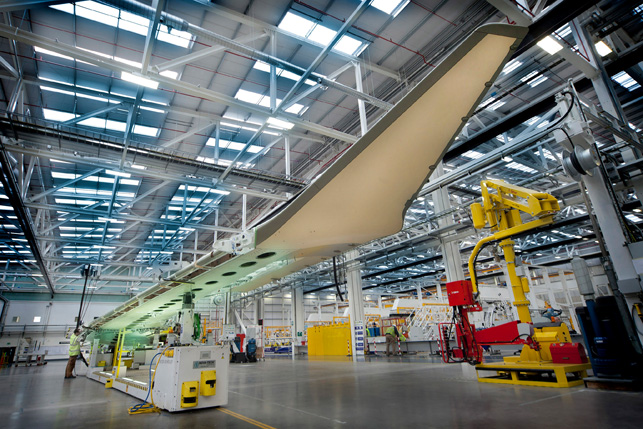Martyn Day is depressed by Brexit but encouraged by the country’s renewed interest in all things manufacturing. He just hopes this isn’t lip service to win over the electorate

Bombardier’s Belfast wing facility – an example of instability caused by trade deals, with thousands of livelihoods on the line
I have to be honest and say I’m having a tough time dealing with the Brexit decision. While others talk of sovereignty and taking back control, all I see is disruption and threats to businesses, supply chains, jobs and livelihoods.
When you are making a product and have monthly bills and wages to pay, the acknowledgement of ‘short term impact’, softened by promises of good times years hence, just doesn’t make any sense to me.
To reach these ‘sunlit uplands’, firms need to survive the predicted trough, new tariffs, disrupted supply chains and get to grips with ‘rules of origin’ issues.
The one positive thing that Brexit has thrown up is the fact that Britain has been reassured that it does indeed have a thriving engineering, design and manufacturing industry. We make a lot of cars, produce steel and have a very important aerospace industry.
The population now understands what a supply chain is, how ‘just in time’ production works and how manufacturers source parts from all around the EU to assemble them into everyday products and machines.
I am now regularly seeing in-depth analyses of UK-based engineering firms — companies such as Airbus, Nissan, JLR, Rolls Royce — and the challenges they face with Brexit. We even have Trump’s kneejerk 300% tariffs to thank for some great analysis and footage of Bombardier’s wing fabrication plant in Belfast.
We may be a services economy, but we do still make some great things here, even though the coverage is mainly about how the companies that make them are now threatened.
Alongside all this wonderful in-depth coverage, we have politicians like Corbyn promising to ‘bring manufacturing back to the UK’. Promising products like train carriages will be made in the UK, through a future Labour government providing support using taxpayers’ money to grow our industry. Sticking two fingers up at globalisation and promising ‘UK engineering jobs for our people’, whatever that entails.
However, there is a slight problem with all this.
The average age of an engineer in a British firm is currently 56. When it comes to degrees, only 6% of students pick an engineering-related degree. In fact, if it wasn’t for foreign students, many further education courses in engineering and technology wouldn’t be economically viable, due to lack of uptake.
According to a report from EngineeringUK, the UK currently produces 46,000 graduates a year, and by 2020, should Brexit go well/not happen, industry will need 87,000 new recruits a year. We have a retiring generation of engineers and a deficit of new graduates.
To add to the problems, students with proven logical and numerate skills are prime candidates for recruitment into jobs in the banking and accounting sectors.
Apprenticeship starts are down 31% this year, restricting the opportunities to recruit and train new blood, and not just in engineering. The key obstacle here seems to be an apprenticeship levy, which removes incentives for some firms to offer positions through job training schemes.
Any politician or government-in-waiting that wants to ‘big up’ British engineering needs to acknowledge that, while Brexit and trading conditions are problems from next March onwards, a historic lack of investment and foresight has produced a generational ticking timebomb.
We need to start early and we need to start young, because so many kids are not encouraged to take science subjects at school, and it would appear that the many young women never consider taking STEM subjects at all.
Only 11% of the UK engineering workforce is female, the lowest rate in Europe. In the US, by contrast, the proportion lies somewhere between 18% and 20%. In China, 40% of engineers are women, and in the former USSR, women account for 58% of the engineering workforce.
Something is going very wrong in our schools, perhaps in our society in general, but in order to compete in technology, engineering and fabrication, STEM needs to win over considerably more of our kids than it does today.
While I am horrified to have become an armchair trade deal ‘expert’ and now know a hell of a lot more about the WTO than any member of the public should, with the spotlight currently being shone on UK manufacturing, this seems like a great time to start raising the issue of where the next generation of engineers will come from.
We need to engage in schools, destroy the imbalance between boys and girls studying STEM subjects, sort out the apprenticeship ‘problem’ and offer comprehensive retraining opportunities for older workers.
I hope that as the debate continues, UK manufacturing remains in the spotlight, and the ‘powers that be’ listen to the needs of these firms and start digging deeper into the structural imbalance of the UK workforce.
Meanwhile, I’m just going to keep reading the headlines with my head in my hands.
Will Brexit woes force a rethink on the future engineering workforce?
Default






